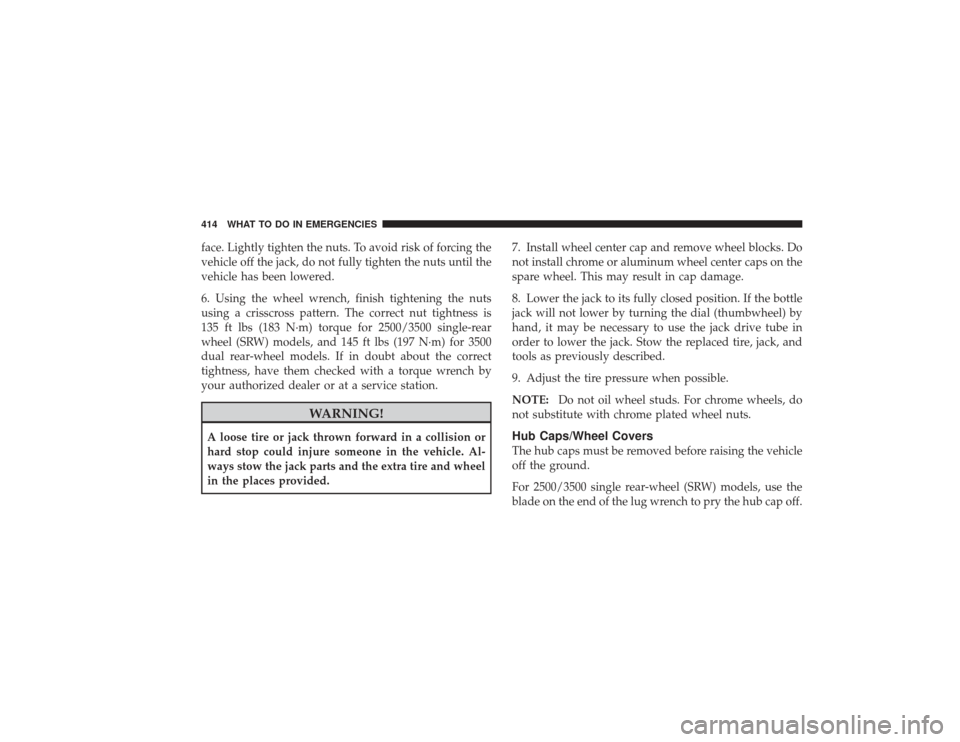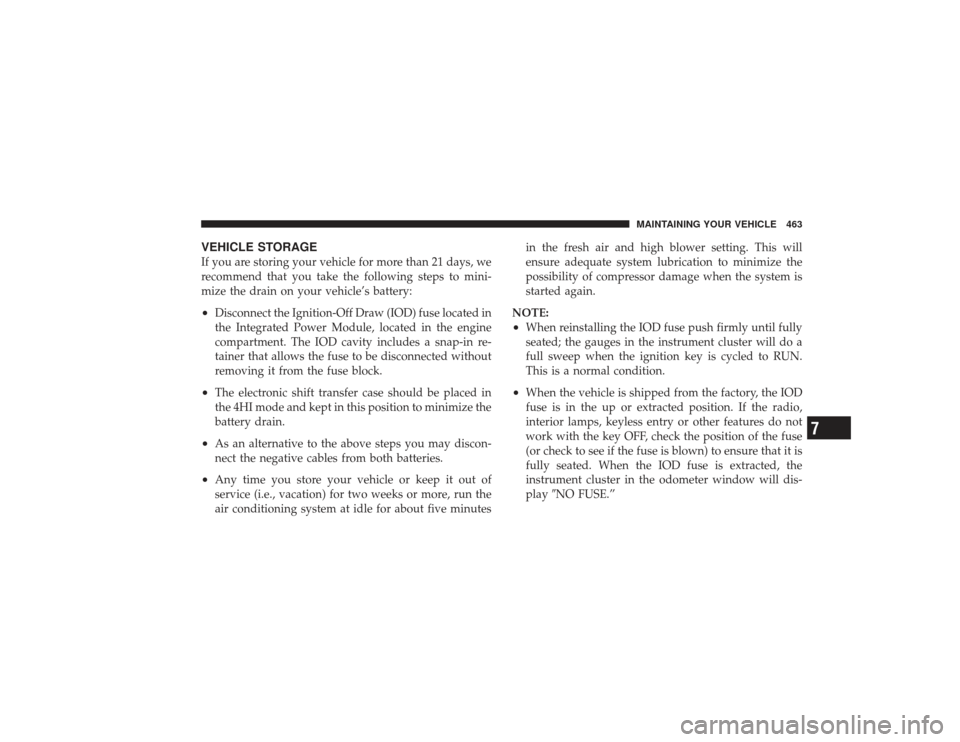Page 416 of 532

face. Lightly tighten the nuts. To avoid risk of forcing the
vehicle off the jack, do not fully tighten the nuts until the
vehicle has been lowered.
6. Using the wheel wrench, finish tightening the nuts
using a crisscross pattern. The correct nut tightness is
135 ft lbs (183 N·m) torque for 2500/3500 single-rear
wheel (SRW) models, and 145 ft lbs (197 N·m) for 3500
dual rear-wheel models. If in doubt about the correct
tightness, have them checked with a torque wrench by
your authorized dealer or at a service station.
WARNING!
A loose tire or jack thrown forward in a collision or
hard stop could injure someone in the vehicle. Al-
ways stow the jack parts and the extra tire and wheel
in the places provided.7. Install wheel center cap and remove wheel blocks. Do
not install chrome or aluminum wheel center caps on the
spare wheel. This may result in cap damage.
8. Lower the jack to its fully closed position. If the bottle
jack will not lower by turning the dial (thumbwheel) by
hand, it may be necessary to use the jack drive tube in
order to lower the jack. Stow the replaced tire, jack, and
tools as previously described.
9. Adjust the tire pressure when possible.
NOTE:
Do not oil wheel studs. For chrome wheels, do
not substitute with chrome plated wheel nuts.
Hub Caps/Wheel CoversThe hub caps must be removed before raising the vehicle
off the ground.
For 2500/3500 single rear-wheel (SRW) models, use the
blade on the end of the lug wrench to pry the hub cap off.
414 WHAT TO DO IN EMERGENCIES
Page 439 of 532

Body LubricationLocks and all body pivot points, including such items as
seat tracks, door hinge pivot points and rollers, liftgate,
tailgate, sliding doors and hood hinges, should be lubri-
cated periodically with a lithium based grease such as
MOPAR�Spray White Lube to assure quiet, easy opera-
tion and to protect against rust and wear. Prior to the
application of any lubricant, the parts concerned should
be wiped clean to remove dust and grit; after lubricating
excess oil and grease should be removed. Particular
attention should also be given to hood latching compo-
nents to ensure proper function. When performing other
underhood services, the hood latch, release mechanism
and safety catch should be cleaned and lubricated.
The external lock cylinders should be lubricated twice a
year, preferably in the Fall and Spring. Apply a small
amount of a high quality lubricant such as MOPAR�
Lock Cylinder Lubricant directly into the lock cylinder.
Windshield Wiper BladesClean the rubber edges of the wiper blades and the
windshield periodically with a sponge or soft cloth and a
mild nonabrasive cleaner. This will remove accumula-
tions of salt or road film.
Operation of the wipers on dry glass for long periods
may cause deterioration of the wiper blades. Always use
washer fluid when using the wipers to remove salt or dirt
from a dry windshield.
Avoid using the wiper blades to remove frost or ice from
the windshield. Keep the blade rubber out of contact with
petroleum products such as engine oil, gasoline, etc.
MAINTAINING YOUR VEHICLE 437
7
Page 461 of 532
Cavity CartridgeFuseMini
Fuse Description
1 20 Amp
YellowPower Outlet Console
2 20 Amp
YellowCabin Compartment
Node (CCN) Door
Locks
3——
4 15 Amp
BlueAisin Transmission
Controls (Diesel Only)
5 20 Amp
YellowPower Sunroof
6 10 Amp
RedVistronic Fan/
Wastegate Solenoid
7——
8 10 Amp
RedHeated Mirrors
Cavity Cartridge
FuseMini
Fuse Description
9 30 Amp Pink Off Road Module
Power
10 5 Amp
OrangeTrx-Off Rd Pkg Sen
(Gas Engine Only)
NOTE: Insert 5 amp
fuse in this cavity to
enable the TRX capa-
bility (If Equipped).
11 20 Amp
Yellow Ignition Off Draw
(IOD)-Cabin Com-
partment Node
(CCN)/Radio/Under
Hood Lamp/Wireless
Control Module
(WCM)/Satellite Digi-
tal Audio Receiver
(SDARS)/Hands Free
Module (HFM)/EOM
MAINTAINING YOUR VEHICLE 459
7
Page 465 of 532

VEHICLE STORAGEIf you are storing your vehicle for more than 21 days, we
recommend that you take the following steps to mini-
mize the drain on your vehicle’s battery:•
Disconnect the Ignition-Off Draw (IOD) fuse located in
the Integrated Power Module, located in the engine
compartment. The IOD cavity includes a snap-in re-
tainer that allows the fuse to be disconnected without
removing it from the fuse block.
•
The electronic shift transfer case should be placed in
the 4HI mode and kept in this position to minimize the
battery drain.
•
As an alternative to the above steps you may discon-
nect the negative cables from both batteries.
•
Any time you store your vehicle or keep it out of
service (i.e., vacation) for two weeks or more, run the
air conditioning system at idle for about five minutesin the fresh air and high blower setting. This will
ensure adequate system lubrication to minimize the
possibility of compressor damage when the system is
started again.
NOTE:
•
When reinstalling the IOD fuse push firmly until fully
seated; the gauges in the instrument cluster will do a
full sweep when the ignition key is cycled to RUN.
This is a normal condition.
•
When the vehicle is shipped from the factory, the IOD
fuse is in the up or extracted position. If the radio,
interior lamps, keyless entry or other features do not
work with the key OFF, check the position of the fuse
(or check to see if the fuse is blown) to ensure that it is
fully seated. When the IOD fuse is extracted, the
instrument cluster in the odometer window will dis-
play �NO FUSE.”
MAINTAINING YOUR VEHICLE 463
7
Page 469 of 532
5. Unlock and pull the connector straight from the base
of the headlight halogen bulb.
6. Twist the connector on the side marker/turn signal/
park light bulb
1�4turn and remove the connector and
bulb from housing.
Headlight Removal
Bulb Removal
MAINTAINING YOUR VEHICLE 467
7
Page 470 of 532
7. Remove the housing from vehicle with the headlight
halogen bulb in housing.
8. Twist the headlight halogen bulb
1�4turn and remove
the headlight bulb from the housing.
9. Replace headlight or side marker/turn signal/park
light bulb. Do not touch the headlight halogen bulb.
10. Reverse the procedure for installation of bulbs and
housing.
Fog Lights1. Reach under the vehicle, unlock and twist the connec-
tor counterclockwise
1�4turn and remove the connector
and bulb from the housing.
468 MAINTAINING YOUR VEHICLE
Page 472 of 532
2. Pull the housing straight out from the body, with a
quick motion, to separate the housing from the body. If
not pulled straight, locators may be damaged.3. Rotate the bulb socket counterclockwise to remove
from the housing.
Pulling Housing From Body
Rotating Bulb Socket From Housing
470 MAINTAINING YOUR VEHICLE
Page 473 of 532
4. Pull the bulb straight out of socket.5. Reverse the procedure to install the bulb and housing.
Place the two raised blocks past the body.
Pulling Bulb From Socket
Sliding Raised Blocks Past Body
MAINTAINING YOUR VEHICLE 471
7